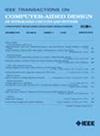频率可调量子芯片的物理启发串扰感知映射和门调度
IF 2.9
3区 计算机科学
Q2 COMPUTER SCIENCE, HARDWARE & ARCHITECTURE
IEEE Transactions on Computer-Aided Design of Integrated Circuits and Systems
Pub Date : 2024-11-27
DOI:10.1109/TCAD.2024.3507580
引用次数: 0
摘要
串扰对量子计算提出了重大挑战,特别是当量子门并行执行时,因为量子比特频率共振会导致剩余耦合和降低门保真度。目前的解决方案在频率可调量子芯片上的并行双量子位门操作中难以减轻串扰和退相干。为了解决这个问题,我们提出了一种串扰感知映射和门调度(CAMEL)方法,旨在通过利用可调谐耦合器的物理特性和结合脉冲补偿技术来减轻串扰和抑制退相干。CAMEL在两步编译框架内运行:首先,考虑串扰和退相干的量子位映射策略;第二,门时序调度方法,优先执行最大可能的无串扰并行门,减少整体电路执行时间。评估结果表明,与串扰不可知方法相比,CAMEL具有更好的减轻串扰的能力,同时成功地抑制了其他方法失败的退相干。此外,CAMEL比动态频率感知技术性能更好,特别是在低复杂性硬件环境中。本文章由计算机程序翻译,如有差异,请以英文原文为准。
CAMEL: Physically Inspired Crosstalk-Aware Mapping and Gate Scheduling for Frequency-Tunable Quantum Chips
Crosstalk poses a significant challenge in quantum computing, particularly when quantum gates are executed in parallel, as qubit frequency resonance can lead to residual coupling and reduced gate fidelity. Current solutions struggle to mitigate both crosstalk and decoherence during parallel two-qubit gate operations on frequency-tunable quantum chips. To address this, we propose a crosstalk-aware mapping and gate scheduling (CAMEL) approach, designed to mitigate crosstalk and suppress decoherence by leveraging the tunable coupler’s physical properties and incorporating a pulse compensation technique. CAMEL operates within a two-step compilation framework: first, a qubit mapping strategy that considers both crosstalk and decoherence; and second, a gate timing scheduling method that prioritizes the execution of the largest possible set of crosstalk-free parallel gates, reducing overall circuit execution time. Evaluation results demonstrate CAMEL’s superior ability to mitigate crosstalk compared to crosstalk-agnostic methods, while successfully suppressing decoherence where other approaches fail. Additionally, CAMEL performs better than dynamic-frequency-aware techniques, particularly in low-complexity hardware environments.
求助全文
通过发布文献求助,成功后即可免费获取论文全文。
去求助
来源期刊
CiteScore
5.60
自引率
13.80%
发文量
500
审稿时长
7 months
期刊介绍:
The purpose of this Transactions is to publish papers of interest to individuals in the area of computer-aided design of integrated circuits and systems composed of analog, digital, mixed-signal, optical, or microwave components. The aids include methods, models, algorithms, and man-machine interfaces for system-level, physical and logical design including: planning, synthesis, partitioning, modeling, simulation, layout, verification, testing, hardware-software co-design and documentation of integrated circuit and system designs of all complexities. Design tools and techniques for evaluating and designing integrated circuits and systems for metrics such as performance, power, reliability, testability, and security are a focus.

 求助内容:
求助内容: 应助结果提醒方式:
应助结果提醒方式:


